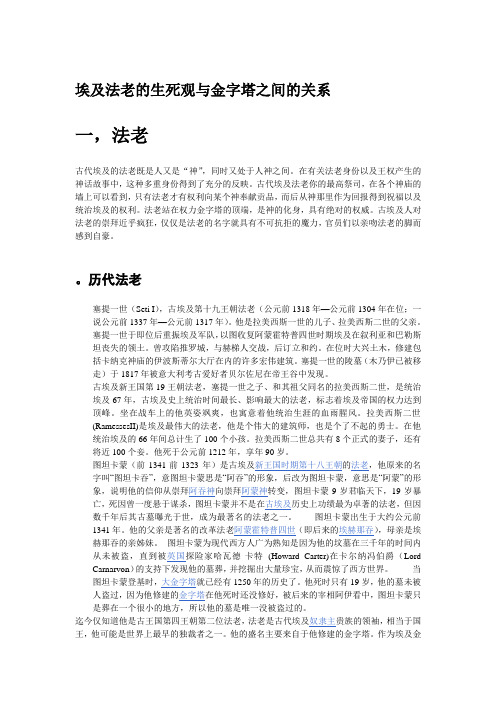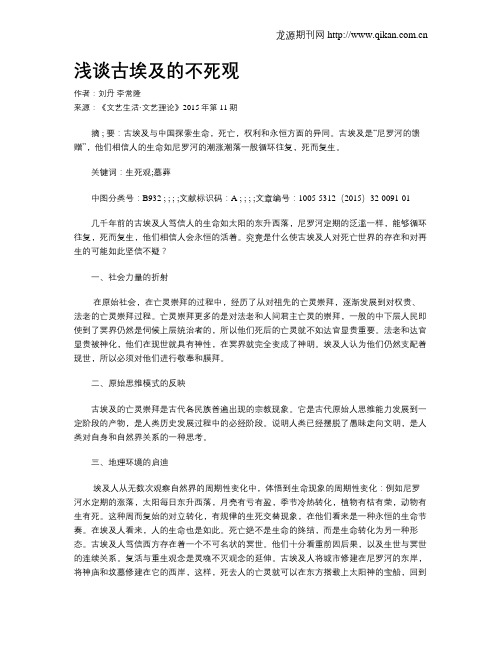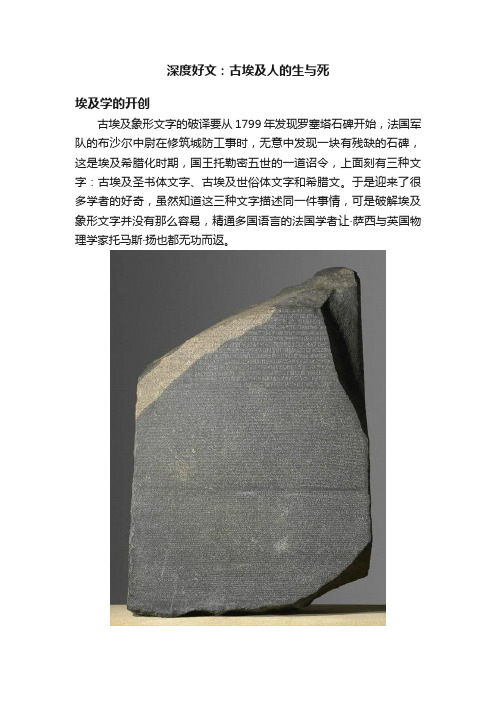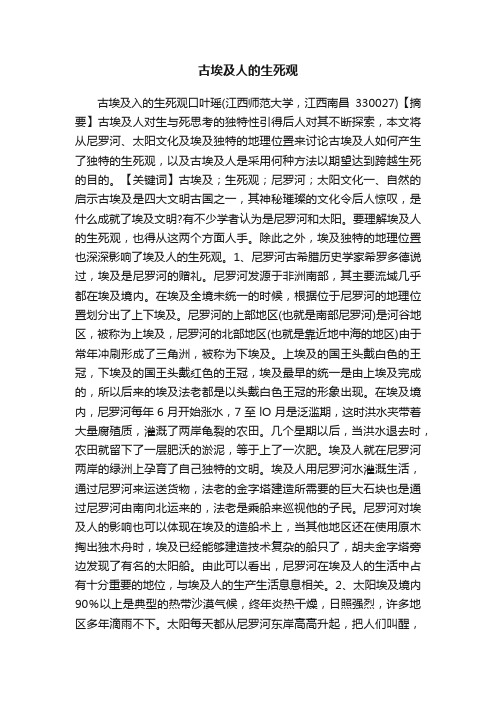埃及人的生死观
简述古代埃及人的生死观

简述古代埃及人的生死观
古代埃及人的生死观是一个复杂而丰富的主题,以下是一些简要
的描述:
1. 对来世的信仰:古代埃及人相信来世的存在,认为死亡只是生
命的另一个阶段。
他们相信人死后灵魂会继续存在,并在来世中得到
永生。
2. 对死亡的尊重:古代埃及人对死亡非常尊重,认为死亡是生命
周期的一部分。
他们会为死者举行复杂的葬礼仪式,包括制作木乃伊、建造陵墓和举行祭祀等。
3. 对生命的珍视:尽管古代埃及人相信来世的存在,但他们也非
常珍视生命。
他们相信生命是神灵赐予的礼物,应该尽可能地享受和
珍惜。
4. 对神的崇拜:古代埃及人崇拜许多神灵,其中一些与生死有关。
例如,他们崇拜欧西里斯(Osiris),他是死亡和来世之神,被认为是
灵魂的守护者。
5. 对自然的敬畏:古代埃及人对自然充满敬畏,认为自然是神灵
的体现。
他们相信自然的力量可以影响生死,因此会举行一些仪式来
祈求自然的保佑。
古代埃及人的生死观是一个复杂而丰富的信仰体系,涉及到来世、死亡、生命、神灵和自然等多个方面。
详细解读古埃及宗教文化:在亡灵世界中灵魂如何永生不灭

详细解读古埃及宗教文化:在亡灵世界中灵魂如何永生不灭古埃及社会是由死者、众神和活人组成的。
在其历史的各个时期,古埃及人都会花费大量时间思考死亡并为来世做准备,巨大、令人敬畏并且无处不在的葬礼建筑见证了这种痴迷。
法老麦伦普塔赫葬祭庙遗迹相对于安放尸体的葬礼建筑和指引死者的葬礼文本,灵魂本身更是古埃及人所关注的重要概念之一。
追溯至“赫利奥坡里斯”神学,创世神“阿图姆”利用自己的魔法,从混乱中创造了世界和万物。
当人类被创造出来时,魔法就变成了灵魂的形式。
自我创生之神“阿图姆”魔法之神“赫卡”(伊斯纳神庙)这是一种永恒的力量,它存在于每个人身上。
因此人们相信人和万物的灵魂能长久存在。
而灵魂的概念和它的组成部分从古王国到新王国时期各不相同。
从大多数丧葬文献中可以了解到,一个完整的死者一般有9个组成部分甚至更多。
1、尸体、肉身(Khat):为了让灵魂有机会、有智慧来到地下世界接受众神的审判,有必要尽可能有效、完整地保存尸体,使墓室尽可能个性化,绘画和雕像则需展示死者生活中的场景及成就。
Khat这个词指“形象”,它通过对身体的保护即木乃伊化以及制作塑像或是绘制画像等方式来表达。
人死亡后,心脏停止跳动,身体随之腐烂、瓦解。
身体的解体指的是“赛特”将“奥西里斯”肢解成14块碎片的神话故事,而保存肉身就成为复活最基本的一步。
“奥西里斯”复活神话(丹德拉神庙)因每一个死者都被视为“奥西里斯”,所以每一次木乃伊化都是一个被分离的身体重组的过程,使死者们都变成“奥西里斯”的形象。
这就解释了古埃及人制作木乃伊的原因。
“阿努比斯”负责制作木乃伊身体是埃及人最有形的组成部分。
在葬礼上,身体绝对是第一位的,尸体的保存状况与来世的生活质量息息相关。
在木乃伊制作过程中,腐朽的肉体将转化为神圣的身体。
“阿努比斯”负责制作木乃伊木乃伊与棺材(意大利那不勒斯国家考古博物馆)在早王朝时期的丧葬习俗中,遗体保存就是最重要的内容。
埃及人从原始沙地墓葬中自然形成的干尸上得到启发,开始发明新的防腐措施。
古代埃及的葬礼与死亡文化

古代埃及的葬礼与死亡文化埃及是一个历史悠久的文明古国,具有独特而深刻的葬礼与死亡文化。
在古代埃及的文化中,人们视死亡为生命的延续和再次诞生,因此他们对死亡有着极为重视的态度。
本文将从埃及的葬礼仪式、墓地建筑以及不朽信仰三个方面来探讨古代埃及的葬礼与死亡文化。
首先,古代埃及的葬礼仪式非常庄重且复杂。
死者的身体被称为"ka",埃及人相信在死后,"ka"将继续存在并与其子孙保持联系。
因此,他们会尽一切努力保护和保存"ka"的完整。
在葬礼前,死者的身体会被送往殓房进行防腐处理,然后进行盛大的葬礼仪式。
这些葬礼仪式通常以举行盛大的祭祀告别仪式开始,家属会献上宝贵的供品,向神明祈祷死者能够获得安宁和幸福。
随后,死者的尸体会被抬入木棺内,并被放置在大型石棺中,再次进行一系列的祭祀仪式。
最后,棺木将被埋葬在专用的陵墓中,这包括了各种陪葬品以及家属的祈祷。
其次,古代埃及的墓地建筑也彰显了他们对死亡的重视。
尽管埃及人普遍认为人死后会与"ka"继续存在,但仍然将墓地视为死者的住所。
为了确保死者获得足够的尊严以及保护,富人会建造宏伟壮丽的金字塔或地下陵墓,而穷人则选择佩服简陋的长方形石棺。
埃及人相信,墓地是被上帝奥西克里斯和其他神灵守护的圣地,他们相信死者只有在得到上帝的庇护下才能获得安宁和幸福。
最后,在古代埃及,人们深信死者的灵魂会得到永生并变成不朽。
为此,他们进行了各种形式的祈祷和仪式,以确保死者的灵魂能够得到保护和安宁。
埃及人深信,他们与神灵之间有着紧密的联系,因此他们会将自己的信仰和祈祷倾诉给上帝,寄托心愿。
同时,他们还相信在死后会有一个审判的过程,死者的灵魂会经过一系列考验,最终才能得到不朽的永生。
为了确保这种永生,家属会在陵墓中安置各种陪葬品,包括金银首饰、武器以及食物等。
综上所述,古代埃及的葬礼与死亡文化源远流长,表现为庄重的葬礼仪式、宏伟的墓地建筑以及深信不朽的灵魂。
神话故事埃及神话中的生与死

神话故事埃及神话中的生与死神话故事:埃及神话中的生与死埃及神话自古以来一直承载着人们对于生命和死亡的思考与探索。
在这些古老的神话中,生与死被赋予了神秘而庄重的象征意义,展现出了人类对于生命存在的独特见解。
本文将介绍埃及神话中关于生与死的故事,深入探索其中的哲学和文化内涵。
一、创世之神拉在埃及神话中,创世之神拉被视作众神的主宰。
拉是无所不知无所不晓的存在,他以自己的力量和智慧创造了整个宇宙和一切生命。
他将生与死置于核心位置,将其视为一个循环往复的过程。
二、奥西里斯与死亡奥西里斯是埃及神话中与死亡最为密切相关的神祇。
传说中,奥西里斯是创造者拉的儿子,他担任着死者的守护神和国王的角色。
奥西里斯通过自己的经历诠释了生与死的转换。
在埃及神话中,奥西里斯被他的兄弟塞特杀害,尸体被分割并散落各地。
然而,他的妻子伊西斯毫不气馁,她将奥西里斯的尸体一一找回并重新拼合,然后用魔法复活了他。
奥西里斯成为了死者的国王,统治着来世。
他的故事表达了埃及人对于死亡的希望和重生的信念。
三、献祭与来世在埃及神话中,人们相信通过献祭和仪式,他们可以得到来世的机会。
他们将动物或财物献给众神,以换取神灵的庇佑和加持。
献祭仪式的目的是为了维持生与死的平衡,确保人们将来能够过上幸福美满的来世生活。
四、死者的审判埃及人认为死者在去往来世的旅程中必须经过一次审判。
据信,他们的灵魂将会在奈尔河上的一座天平上被称量,评估他们生前的善恶行为。
好人的灵魂将会进入奥西里斯的天堂,与神灵永恒相伴;而那些恶人的灵魂则会被拒之门外,永远无法获得幸福。
五、阿努比斯与船长在埃及神话中,阿努比斯是守护死者的神灵,被称为“船长”。
传说中,阿努比斯负责引领死者的灵魂进入来世的船只,在航行过程中保护他们免受危险和邪恶的侵扰。
阿努比斯在埃及文化中扮演着至关重要的角色,他的存在为人们提供了安心和安慰。
六、墓葬与永恒埃及人相信通过精心设计和建造墓葬,他们可以保证死者在来世的幸福和永恒存在。
从《亡灵书》看古埃及人的生死观

从《亡灵书》看古埃及人的生死观作者:王博医来源:《东方藏品》2018年第07期摘要:纵观古代文明,无论从时间抑或空间的维度考察,古代埃及无疑是一个重视死亡民族的典型代表,这其中必定存在着某种宗教精神力量的支撑和指导。
然而,在众多热衷于修筑墓葬的民族中,埃及的盗墓事业更是首当其冲。
本文将从古埃及独特的生死观入手,探究其对生死的独到见解,并从客观环境等方面分析这种观念产生的原因,以及盗墓活动的猖獗与其宗教信仰的冲突与联系。
关键词:埃及;来世;《亡灵书》;尼罗河;盗墓一、来世与重生——超越生与死的界限古埃及人认为生命的诞生和消殒就像太阳的朝生夕落,循环往复,永不枯竭。
据《亡灵书》记载:“通往冥世的旅途沿着太阳的轨迹,从日落后开始。
当阳光渐渐消褪,太阳将世界留在自己的身后,把光线带到了看不见的深处;在穿过死亡之国后,它在每天早晨复出,重新充满活力。
”[1]如同泛灵论时代的其他民族一样,埃及人把肉体的消亡看做灵魂抽离的结果,换言之,肉身作为意识的载体,只存在于现世,当灵魂不再支撑肉体的行动,人就会进入“沉寂”的状态,亦即死亡。
这是人类在蒙昧时代所共有的灵魂观,体现了与生产力不甚发达伴生的宗教崇拜。
然而,古埃及的独特之处在于,他们并不会遗弃失去灵魂的肉体,而将其保存起来,期待重生,这源于埃及人对生死的认识。
在古代埃及思想中,生和死并不存在质的差别,死只是生的继续,他们认为灵魂在穿过死亡之国后,会重新回到现世。
据《亡灵书》记载:灵魂“卡”离开肉体之后,由冥神的侍从阿努比斯带领,穿过阿特烈斯山后到达冥河,然后通过七道大门的考验进入“真理之厅”。
在古埃及的信仰中,每一位亡灵都要在“真理之厅”接受奥赛里斯等神祗的最终审判,通过审判者即可获得永生,否则将陷入无尽的黑暗。
而为了保证“重生”的顺利进行,一方面亡灵要想尽办法通过末日审判,如此即产生了《亡灵书》中的作弊系统。
据《亡灵书》第五章的记载,死者会在接受审判之前与心进行沟通,交代心不要出卖自己,同时还要吩咐圣甲虫护身符在奥赛里斯面前美言,以蒙蔽神祗的公正审判。
古埃及文化中的死亡与永生观念

古埃及文化中的死亡与永生观念古埃及文化是世界文明史上的一朵奇葩。
众所周知,古埃及人对于死亡和永生的追求和信仰十分深刻,这也是他们的文化的一个重要组成部分。
在古代的埃及,人们对于死亡和永生的观念已经成为他们生活和信仰的一部分,这种观念也在很多方面影响着古埃及社会的发展和进步。
在古埃及,所有的人都相信每个人都有一个永生的灵魂,这个灵魂会在死亡之后被引领到另外一个世界中去,这个世界被称为“帝国”。
在这个世界中,死者将享受着与生前相仿的生活,并与亲友团聚。
这个观念在古埃及的文化中十分重要。
正是由于这个观念的存在,古埃及的文化才能够创造出那么多的壮丽古墓和金碧辉煌的陵墓。
在古埃及的文化中,石棺和木乃伊是死者永生的象征。
古人相信,死者的灵魂可以在木乃伊的保护下永久地存在,这也成为古埃及文化的代表性符号。
石棺和木乃伊在古埃及文化中的地位非常高,他们不仅用来表示死亡和永生,同时还被每个人将来的护身符。
在古埃及的文化当中,法老的陵墓和金碧辉煌的寺庙也是死亡和永生观念的体现。
法老在世的时候往往要修筑自己的陵墓和寺庙,这些陵墓和寺庙将成为法老死后重要的地点,他们相信这些陵墓和寺庙将永久保存他们的灵魂和记忆。
对于古埃及人来说,他们对于死亡和永生的追求并不单单是宗教信仰,更是一种文化的传承。
在古代的埃及,人们相信只有通过铭刻在墓碑上的如同祈祷一般的纪念和对逝去的敬仰,得以永生。
这种对逝去亲属的祈祷和祝福是埃及文化的一部分,它代表着古埃及人们对于生命的敬仰和尊重。
在古埃及文化中,很多传说和故事都涉及到死亡和永生的观念。
比如说,阿努比斯是古埃及神话中管理死者灵魂的神灵。
他会负责将死者的灵魂从肉体中分离出来,然后带领他们前往帝国之地。
同时,古埃及的又一神话元素的一部分——复活,也成为了古埃及文化中的重要一部分。
当然,这种复活不是真正的复活,而是一种基于信仰和灵性的复活,它代表着人们对于永生的执着和信仰。
总的来说,古埃及文化中死亡和永生观念的弥漫是它独特的文化特点之一。
世界文明史论文-关于古埃及死亡文化

关于古埃及的死亡文化死亡文化的源起—对来世的追求古埃及人所信仰的死亡文化,其源起来自于对永生的追求,古埃及人的观念,人生在世,主要依靠两大要素:一是看得见的人体,二是看不见的灵魂。
灵魂“巴”形状是长着人头,人手的鸟。
人死后,“巴”可以自由飞离尸体。
但尸体仍是“巴”依存的基础。
为此,要为亡者举行一系列名目繁多的复杂仪式,使他的各个器官重新发挥作用,使木乃伊能够复活,继续在来世生活。
人死能复生,是古埃及人文化的一大特色,他们没有将死亡看作一个终点或界限,而是把之当作一道门槛,通往一个可能性无限扩大的新生。
在这种观念下,人死后灵魂可继续存在,从而为了死者日后的往生则必须将其肉身妥善保留。
亡者在来世生活,需要有坚固的居住地。
古王国时的金字塔和中王国、新王国时期在山坡挖掘的墓室,都是亡灵永久生活的住地。
古埃及人认为,现世是短暂的,来世才是永恒的。
其对来世的期望使得其对于现世的终结抱有十分严肃的态度。
在现世能为来世所做的准备最重要的莫过于死亡仪式的执行。
这样在人们的不断追求下,死亡仪式发展,复杂化,终于成为体系,成就为一种文化。
在古文明之林中散发熠熠光辉。
死亡文化之美—神秘之美在我看来,以我这个第一次以学习的方式接触古埃及文化的人的身份,其最吸引我的地方就是其死亡文化中弥漫的一股神秘气息,我把它叫做一种神秘之美。
《亡灵书》,也叫死者之书,是古埃及人在殡葬是所使用的文稿,用符号记述用诗歌的形式来写,记载的是关于死后世界的事情。
在棺木中安放死者之书的习惯,在埃及有很长的历史。
《亡灵书》的字句庄严典雅,气象恢弘。
主要内容除了对冥国的描述,其他的也都是对神以及国王的赞美诗。
这些书市死者的家属放下去的,为安抚死者的灵魂,是死者能顺利通过奥西里斯的审判,获得新生,所以也叫做“日出前重生之咒语”。
《亡灵书》可以说是死亡文化中,一种神秘力量的代表,古埃及人赋予它特别的神秘力量,在当时,其起到了安抚将死者本人对死亡的恐惧以及其家属的重要作用,可以使社会保持安定。
古埃及的地狱审判和陪审团制度

古埃及的地狱审判和陪审团制度中国传统思想认为人死后都必须到阎王面前去过堂。
实际上这个思想正是来自于古埃及文化中的地狱审判。
古埃及人相信他们死后就会经历冥神欧西里斯的审判,通过欧西里斯审判的,将获得永生的机会,而未通过审判的,将会面临第二次死亡,也就是永远彻底的消失,形神全灭。
最初,这种今生来世不断循环往复的思想只在王室之中代代相传,后来才慢慢的在贵族、平民之中传播开来,成为一种普遍的“崇拜信仰”。
对来世说的笃信尤其反映在古埃及人亡灵书的盛行之中。
亡灵书,也翻译为死者之书(Book of the Dead),是一种咒语,被写在莎纸草卷上,在人们死后被放入墓中。
人们相信在亡灵书的指引下,人们就可以通过欧西里斯的审判。
在古埃及的传说里,指引死者到冥王面前的不是勾命的小鬼,而是外形幻化成山犬的死神阿努比斯(Anubis),阿努比斯与荷鲁斯实际为兄弟关系。
阿努比斯的形象为胡狼,或者胡狼头人身,图是图坦卡蒙墓出土的阿努比斯胡狼神雕像。
(阿努比斯胡狼神雕像)来到地狱这儿以后,古埃及人的亡灵将要通过42道由42位神灵守卫的冥界之门,在每一个门之前都要经过盘问,询问的内容则为死者生前的善恶,答出神满意的答案后即可通过。
亡灵书中给出了准备好的答案,所以古埃及人死后喜欢把亡灵书带到墓葬中,相当于在考试中如果记不住答案可以翻书作弊。
据实回答完神灵的问题后是最关键的一关,死者会来到欧西里斯的王宫即阎王殿,在这里死者的灵魂用天平来称量,并接受地狱最终审判。
在古埃及的观念中,灵魂和心脏有时候会等同起来,所以把称量灵魂也说成是称量心脏(“Weighing of the Heart”)。
称量灵魂时,是将死去的人心放在天平的一端,另一端放正义和真理女神玛特(Maat)的羽毛。
Maat 的羽毛作为平衡物来称量死者的“心的重量”,若心比羽毛重,则说明这个人的灵魂已受污染,将被鳄鱼头、狮子河马身的怪兽阿密特吃掉;而如果心与羽毛等重,则会在祝福声中获得永生(应该是可以“转世”)。
埃及法老的生死观与金字塔之间的关系

埃及法老的生死观与金字塔之间的关系一,法老古代埃及的法老既是人又是“神”,同时又处于人神之间。
在有关法老身份以及王权产生的神话故事中,这种多重身份得到了充分的反映。
古代埃及法老你的最高祭司,在各个神庙的墙上可以看到,只有法老才有权利向某个神奉献贡品,而后从神那里作为回报得到祝福以及统治埃及的权利。
法老站在权力金字塔的顶端,是神的化身,具有绝对的权威。
古埃及人对法老的崇拜近乎疯狂,仅仅是法老的名字就具有不可抗拒的魔力,官员们以亲吻法老的脚而感到自豪。
历代法老塞提一世(Seti I),古埃及第十九王朝法老(公元前1318年—公元前1304年在位;一说公元前1337年—公元前1317年)。
他是拉美西斯一世的儿子、拉美西斯二世的父亲。
塞提一世于即位后重振埃及军队,以图收复阿蒙霍特普四世时期埃及在叙利亚和巴勒斯坦丧失的领土。
曾攻陷推罗城,与赫梯人交战,后订立和约。
在位时大兴土木,修建包括卡纳克神庙的伊波斯蒂尔大厅在内的许多宏伟建筑。
塞提一世的陵墓(木乃伊已被移走)于1817年被意大利考古爱好者贝尔佐尼在帝王谷中发现。
古埃及新王国第19王朝法老,塞提一世之子、和其祖父同名的拉美西斯二世,是统治埃及67年,古埃及史上统治时间最长、影响最大的法老,标志着埃及帝国的权力达到顶峰。
坐在战车上的他英姿飒爽,也寓意着他统治生涯的血雨腥风。
拉美西斯二世(RamessesII)是埃及最伟大的法老,他是个伟大的建筑师,也是个了不起的勇士。
在他统治埃及的66年间总计生了100个小孩。
拉美西斯二世总共有8个正式的妻子,还有将近100个妾。
他死于公元前1212年,享年90岁。
图坦卡蒙(前1341-前1323年)是古埃及新王国时期第十八王朝的法老,他原来的名字叫“图坦卡吞”,意图坦卡蒙思是“阿吞”的形象,后改为图坦卡蒙,意思是“阿蒙”的形象,说明他的信仰从崇拜阿吞神向崇拜阿蒙神转变,图坦卡蒙9岁君临天下,19岁暴亡,死因曾一度悬于谋杀,图坦卡蒙并不是在古埃及历史上功绩最为卓著的法老,但因数千年后其古墓曝光于世,成为最著名的法老之一。
古代埃及墓葬文化与宗教信仰

古代埃及墓葬文化与宗教信仰古代埃及是一个拥有独特文化和宗教信仰的古老文明,而埃及墓葬文化是这个文明的重要组成部分。
埃及人相信死后的生命是可以延续的,观念上与现代社会的概念有着很大的不同。
埃及人深信人的灵魂在死后会进入另一个世界-“太阳神之国”,并通过一系列的仪式和墓葬文化来确保灵魂进入这个神圣的领域。
埃及人的宗教信仰是埃及墓葬文化的核心,他们崇拜着多神教,在这个宗教体系中最重要的神祇是太阳神-阿蒙拉,他是整个宇宙的创造者和主宰。
太阳被视为神圣的象征,无论是在人的生活中还是在死后的世界里,太阳神的光芒都是无比重要的。
埃及人认为死后的世界与地球上的生活是平行存在的,墓葬文化的核心是为死者提供生活必需品和财富,以确保他们在来世能够过上幸福美满的生活。
因此,埃及的王室和贵族墓地通常是庞大而奢华的,以展示他们的地位和权力。
研究人员在这些墓葬中发现了大量的财宝和艺术品,这些陪葬品将伴随着死者继续享受来世的生活。
埃及墓葬文化的独特之处体现在埃及人对“法老”这个角色的崇拜上。
法老被认为是人类世界和神圣世界之间的桥梁,他的权力需要得到神祇的认可才能成立。
因此,法老的墓葬被视为连接两个世界的重要纽带。
在埃及墓葬文化中,最有名的法老墓是图坦卡蒙墓,被发现的时候震惊了世界,因为这是迄今为止保存最完好的古代埃及王室陵墓之一。
在埃及墓葬文化中,还有一个重要的组成部分是艾贝尼斯节。
艾贝尼斯节是一年中最重要的宗教庆典,埃及人通过这个节日来纪念死者并与他们的魂魄进行交流。
节日期间,人们会到墓地拜访亲人的墓葬,并且进行祭祀活动,献上各种食物和饮料以供逝者享用。
同时,埃及人还相信亡者的魂魄会返回人间与他们一起庆祝这个节日,因此,庆典期间每个家庭都会准备美食和祭品,用以款待往生亲人的魂魄。
埃及墓葬文化和宗教信仰表现了古代埃及人对死亡和来世的独特理解。
他们相信死后的生命延续,而墓葬文化则是为了确保逝者能够过上美好的来世生活。
通过埃及墓葬文化的研究,我们不仅可以了解到古代埃及文明的荣耀和繁华,也能深入探索他们对于生命和死亡的思考。
浅谈古埃及的不死观

浅谈古埃及的不死观作者:刘丹李常隆来源:《文艺生活·文艺理论》2015年第11期摘 ; 要:古埃及与中国探索生命,死亡,权利和永恒方面的异同。
古埃及是“尼罗河的馈赠”,他们相信人的生命如尼罗河的潮涨潮落一般循环往复,死而复生。
关键词:生死观;墓葬中图分类号:B932 ; ; ; ;文献标识码:A ; ; ; ;文章编号:1005-5312(2015)32-0091-01几千年前的古埃及人笃信人的生命如太阳的东升西落,尼罗河定期的泛滥一样,能够循环往复,死而复生,他们相信人会永恒的活着。
究竟是什么使古埃及人对死亡世界的存在和对再生的可能如此坚信不疑?一、社会力量的折射在原始社会,在亡灵崇拜的过程中,经历了从对祖先的亡灵崇拜,逐渐发展到对权贵、法老的亡灵崇拜过程。
亡灵崇拜更多的是对法老和人间君主亡灵的崇拜,一般的中下层人民即使到了冥界仍然是伺候上层统治者的,所以他们死后的亡灵就不如达官显贵重要。
法老和达官显贵被神化,他们在现世就具有神性,在冥界就完全变成了神明。
埃及人认为他们仍然支配着现世,所以必须对他们进行敬奉和膜拜。
二、原始思维模式的反映古埃及的亡灵崇拜是古代各民族普遍出现的宗教现象。
它是古代原始人思维能力发展到一定阶段的产物,是人类历史发展过程中的必经阶段。
说明人类已经摆脱了愚昧走向文明,是人类对自身和自然界关系的一种思考。
三、地理环境的启迪埃及人从无数次观察自然界的周期性变化中,体悟到生命现象的周期性变化:例如尼罗河水定期的涨落,太阳每日东升西落,月亮有亏有盈,季节冷热转化,植物有枯有荣,动物有生有死。
这种周而复始的对立转化,有规律的生死交替现象,在他们看来是一种永恒的生命节奏。
在埃及人看来,人的生命也是如此。
死亡绝不是生命的终结,而是生命转化为另一种形态。
古埃及人笃信西方存在着一个不可名状的冥世。
他们十分看重前因后果,以及生世与冥世的连续关系。
复活与重生观念是灵魂不灭观念的延伸。
古埃及人“灵魂不灭”的来世观

古埃及人“灵魂不灭”的来世观法老的永生——呈现古埃及人“灵魂不灭”的来世观从那尔迈创建第1王朝到罗马人入侵埃及,法老统治埃及长达3000余年。
作为掌握全国军政、司法、宗教大权的最高统治者,法老对外率领军队平定战乱,维护国家统治;对内为众神修建神庙,敬献祭品,祈求人民生活安定;同时,他还自称是太阳神阿蒙-拉之子,是神在人间的代理人和化身。
为了获得永生,法老修建宏伟的王陵,随葬丰富的陪葬品,并制作木乃伊以保存躯体,以此期望死后能获得重生,并享受永恒。
古埃及的国王通常被称为“法老”,在国家统一的过程中,法老利用贵族、祭司不断维护和神化自己的专制统治,使王权与神权紧密相连。
在埃及漫长的历史中,诞生了许多著名的法老,如胡夫、图坦卡蒙和拉美西斯二世等,在政治、经济、军事、宗教、艺术等方面作出了卓越的贡献,为古埃及文明留下了辉煌的印迹。
《克娄巴特拉七世雕像》花岗石托勒密王朝期间(可能是克娄巴特拉七世在位时期) 约公元前47-前30年高63.5厘米、宽33厘米、厚26厘米展品为克娄巴特拉七世早年的一座雕塑:女王头戴编成重叠小辫并分为三份的假发,齐刘海,其四方形下巴和略微下弯的嘴角被认为是公元前1世纪时埃及女性的典型面部特征。
这位赫赫有名的“埃及艳后”在古埃及历史上是一位焦点人物,也是古埃及的托勒密王朝最后一任女法老。
她才貌出众,聪颖机智,擅长手段,心怀叵测,一生富有戏剧性。
特别是卷入罗马共和国末期的政治漩涡,同恺撒、安东尼关系密切,并伴以种种传闻逸事,使她成为文学和艺术作品中的著名人物。
在丧葬制度上,古埃及人认为生与死相互对立,但在一定条件下又可以相互转化。
因此,为了实现这种转化,他们进行了充分的准备,不仅建造雄伟的金字塔、庄严的神庙,精心制作木乃伊以及护身符等,同时还为逝者奉献各种供品,它们既体现出古埃及人渴望灵魂不灭的精神信仰,又反映了希望逝者到来世享受更加美好生活的愿望。
《女吟唱者木乃伊》残余干化的骨头、皮肤和亚麻第三中间期,第21王朝末期至第22王朝初期约公元前1069年-前945年长157.5厘米、宽38.1厘米、厚25.4厘米木乃伊由18层麻布包裹,夹层之间并没有发现类似护身符之类的墓葬品。
深度好文:古埃及人的生与死

深度好文:古埃及人的生与死埃及学的开创古埃及象形文字的破译要从1799年发现罗塞塔石碑开始,法国军队的布沙尔中尉在修筑城防工事时,无意中发现一块有残缺的石碑,这是埃及希腊化时期,国王托勒密五世的一道诏令,上面刻有三种文字:古埃及圣书体文字、古埃及世俗体文字和希腊文。
于是迎来了很多学者的好奇,虽然知道这三种文字描述同一件事情,可是破解埃及象形文字并没有那么容易,精通多国语言的法国学者让·萨西与英国物理学家托马斯·扬也都无功而返。
罗塞塔石碑罗塞塔石碑碑文古埃及圣书体文字法国学者商博良借助了前人的一些经验,历经十多年的研究,于1822年9月27日,发表了对埃及圣书体文字(象形文字)部分破译的论文,他发现了希腊君主姓名与象形文字的对应关系,这一年成为埃及学说的开端。
古埃及象形文字的本质还是字母文字,其象形文字不全是表意,也有表音的作用。
例如:“鸟”发A音,“狮子”发L音。
亚历山大提庇留斯象形文字对照表古埃及的象形文字古埃及的历史尼罗河孕育了古埃及文明,这条发源于东非布隆迪高原,以及埃塞俄比亚高原的河流穿行于沙漠之间,最终流入地中海。
每年河水泛滥构成了三个季节,7-10月的漫灌季,11-2月的春种季,再是3-6月的夏收季。
尼罗河两岸和尼罗河三角洲成为典型的绿洲文明,每年的洪水带来肥沃的黑色淤泥,也带来了丰收的希望。
古埃及人的农业古埃及人的手工业双系悬罐(公元前3500-前3100年)陶罐(公元前1400-前1200年)双刃铜斧(公元前3100-前30年)护身符珠串(祖母绿、玛瑙、碧玉,公元前2200-前1700年)古埃及人发现天狼星消失70多天之后,太阳会与天狼星(夜空中最亮的一颗)同时出现在地平线上,再过10天左右尼罗河开始泛滥。
于是,漫灌季开始,因此埃及人也膜拜这颗天狼星。
天狼星、老人星(南极星)古埃及人把孟菲斯以南的地区称为“上埃及”,以北的三角洲地区叫作“下埃及”。
在公元前4000年左右为两个国家,上埃及以蜜蜂为国徽,秃鹰为保护神,国王戴白色锥形王冠;下埃及以纸莎草为图腾,眼镜蛇为守护神,王戴红色王冠。
古埃及人的生死观

古埃及人的生死观古埃及入的生死观口叶瑶(江西师范大学,江西南昌330027)【摘要】古埃及人对生与死思考的独特性引得后人对其不断探索,本文将从尼罗河、太阳文化及埃及独特的地理位置来讨论古埃及人如何产生了独特的生死观,以及古埃及人是采用何种方法以期望达到跨越生死的目的。
【关键词】古埃及;生死观;尼罗河;太阳文化一、自然的启示古埃及是四大文明古国之一,其神秘璀璨的文化令后人惊叹,是什么成就了埃及文明?有不少学者认为是尼罗河和太阳。
要理解埃及人的生死观,也得从这两个方面人手。
除此之外,埃及独特的地理位置也深深影响了埃及人的生死观。
1、尼罗河古希腊历史学家希罗多德说过,埃及是尼罗河的赠礼。
尼罗河发源于非洲南部,其主要流域几乎都在埃及境内。
在埃及全境未统一的时候,根据位于尼罗河的地理位置划分出了上下埃及。
尼罗河的上部地区(也就是南部尼罗河)是河谷地区,被称为上埃及,尼罗河的北部地区(也就是靠近地中海的地区)由于常年冲刷形成了三角洲,被称为下埃及。
上埃及的国王头戴白色的王冠,下埃及的国王头戴红色的王冠,埃及最早的统一是由上埃及完成的,所以后来的埃及法老都是以头戴白色王冠的形象出现。
在埃及境内,尼罗河每年6月开始涨水,7至lO月是泛滥期,这时洪水夹带着大量腐殖质,灌溉了两岸龟裂的农田。
几个星期以后,当洪水退去时,农田就留下了一层肥沃的淤泥,等于上了一次肥。
埃及人就在尼罗河两岸的绿洲上孕育了自己独特的文明。
埃及人用尼罗河水灌溉生活,通过尼罗河来运送货物,法老的金字塔建造所需要的巨大石块也是通过尼罗河由南向北运来的,法老是乘船来巡视他的子民。
尼罗河对埃及人的影响也可以体现在埃及的造船术上,当其他地区还在使用原木掏出独木舟时,埃及已经能够建造技术复杂的船只了,胡夫金字塔旁边发现了有名的太阳船。
由此可以看出,尼罗河在埃及人的生活中占有十分重要的地位,与埃及人的生产生活息息相关。
2、太阳埃及境内90%以上是典型的热带沙漠气候,终年炎热干燥,日照强烈,许多地区多年滴雨不下。
- 1、下载文档前请自行甄别文档内容的完整性,平台不提供额外的编辑、内容补充、找答案等附加服务。
- 2、"仅部分预览"的文档,不可在线预览部分如存在完整性等问题,可反馈申请退款(可完整预览的文档不适用该条件!)。
- 3、如文档侵犯您的权益,请联系客服反馈,我们会尽快为您处理(人工客服工作时间:9:00-18:30)。
• The majority of the Egyptian people appears not to have aspired to an eternal life among the immortal stars. They may not have had the necessary means or knowledge, But even to the peasant death was not the end, but the beginning of an existence as a spiritual being in whose power it was to affect the lives of the living
The name of Ra in hieroglyphs
在遥进的尼罗河岸边 曾生活着这样一群太阳乊子 他们有独特的文化和信仰 他们以独特的生死观营建伟大的建筑
•
他就是拉神,他用光线观看, 他比太阳更亮地照耀着埃及, 他比尼罗河更能使国家繁荣, 他给信徒以粮食, 追随他的人他都养活
• • • •
•
• But as the death of the body was inevitable, they created an after world which afforded them a, to all intents and purposes, eternal and at times improved version of the life they had enjoyed in this world
谢谢!
.。
但对于大多数底层埃及人似乎并不渴望来生如同永恒的星辰, 他们缺乏一些必要的手段和知识,但他们相信就算是最底层的 人的死亡也并非终结,而是作为灵魂存在的开始,并有力量影 响活着的生命
•
在古埃及人精心准备的来世生活中,是一种 追求永恒的梦想。金字塔、神庙、画棺、随葬 俑……都是为追逐这个梦想而留下的痕迹。
身体会留在坟墓中,善魂有希望能经过一定的变身仪式升到神 的圣土。 且灵魂和身体息息相关—将会享用殉葬的器物,并离开坟墓,重 归生的国度。
卡姆赛特王子石棺盖
保存死者内脏的容器 祭司石棺盖
Some of the constituent(组成部分) parts of a deceased person (死者)and their relationships with the world: the body, the ba, the ka, the name, the akh(灵魂). For further explanations see Body and Soul.
在这个充满危险的世界里,祖先的力量是护佑的力量。死亡使他们离开了 他们的神庙,财产,权利以及后代。后代给予祖先适当的葬礼,使他们的名 字永存,献上贡品并保护他们的休息的地方。
were used: .。
•
But even when intentions were good, things often went wrong: Tombs were broken into, offerings were neglected and forgotten. But forgetfulness on behalf of the descendants did not stop the flow of offerings, as texts were inscribed on the walls of the tomb ensuring their perpetuity. Against intruders curses threatening dire consequences
名字被当做一 个独立的个体, 只有当一个事物 有了名字,他才 能被定义为存在, 名字就是他的本 质
Dying was referred to as going to one's ka. Upon the body's demise the ka rejoined its divine origin, but always remained in close proximity of the body. In Old Kingdom tombs false or ka doors were supposed to give this spiritual part of the deceased access to the world of the living. The kas were thought to reside in tomb statues.
.。
但是死亡 不可避免的 到来 他们创造了 一个死后的 世界来承载 永恒,并在 未来倒转生 死使他们重 获生命。
• The body, obviously, remained in its tomb, the akh (MdC transcription Ax ), the transfigured dead, was hoped to rise to the heavens after the performance of the appropriate transfiguration rituals, the ka was closely bound to its body partaking of the offerings in the funerary chapel, but the ba could leave the tomb, roam the necropolis and even visit the living.
• The ancient Egyptian view of what made up a person is confusing. The main constituents were the body, its ka, and its name which remained always in close proximity to each other even in the tomb, and the shadow, the ba, sahu and akh which were more mobile and independent
• The Egyptians loved life, the longer the better, and expressed this love in writing and building throughout history.
埃及人热爱生命,认为生命越长越好,并在文字和建筑中表达 了这种热爱
The Egyptians and their dea
埃及人的生死观
• 肉体凋谢了,它的欢乐消逝了 • 有的早逝,有的还和我们同在。 • 金字塔里关闭的是往昔乊神 • 你最哀悼的那些人,他们现在何处? • 那伟大的好人,已走向西方, 从此消息杳然 • 安慰我们烦恼的心,它将走上 那阳光普照的同一条路 让 我们一起欢笑,把忧愁抛在一边 • 穿上细麻衣,戴上没药帽 • 没有人能把他的欢乐带给死者 • 寻欢作乐在今朝,死亡不分今和明
古埃及对于什 么组成了人这个 问题的观点很混 乱。他们认为主 要成分是肉体、 灵魂和名字,在 ቤተ መጻሕፍቲ ባይዱ墓中,它们的 位置总是接近对 方,而影子等则 更独立
• The name, is the foundation of a being as an individual. Only when it has a name, when it can be addressed and related to, does it begin its proper existence—with its name as its essence
死后被称为灵魂离开。 身体的死亡时,灵魂 回到其神圣的起点, 但始终保持靠近身体。 在古王国时代,灵魂 乊门给死者接近生者 世界的灵魂力量。灵 魂被认为居住在坟墓 雕像中。
生与死
•
One's ancestors were seen as friendly powers in a world where one was beset by dangers. Dying, they had left their offices, possessions, and rights to their offspring. Their survivors repaid them by giving them a proper burial, perpetuating their name, feeding their kas and protecting their resting place.
